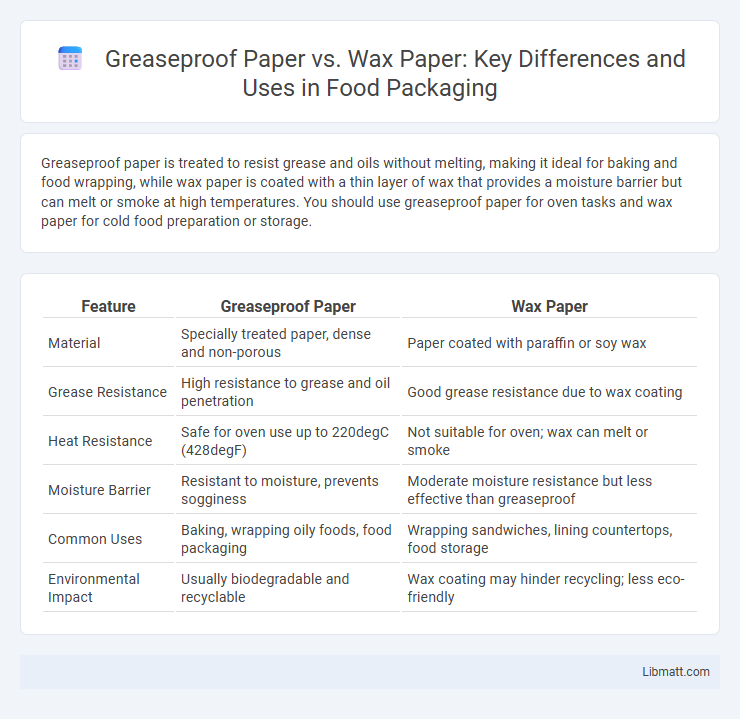Greaseproof paper is treated to resist grease and oils without melting, making it ideal for baking and food wrapping, while wax paper is coated with a thin layer of wax that provides a moisture barrier but can melt or smoke at high temperatures. You should use greaseproof paper for oven tasks and wax paper for cold food preparation or storage.
Table of Comparison
| Feature | Greaseproof Paper | Wax Paper |
|---|---|---|
| Material | Specially treated paper, dense and non-porous | Paper coated with paraffin or soy wax |
| Grease Resistance | High resistance to grease and oil penetration | Good grease resistance due to wax coating |
| Heat Resistance | Safe for oven use up to 220degC (428degF) | Not suitable for oven; wax can melt or smoke |
| Moisture Barrier | Resistant to moisture, prevents sogginess | Moderate moisture resistance but less effective than greaseproof |
| Common Uses | Baking, wrapping oily foods, food packaging | Wrapping sandwiches, lining countertops, food storage |
| Environmental Impact | Usually biodegradable and recyclable | Wax coating may hinder recycling; less eco-friendly |
Introduction to Greaseproof Paper and Wax Paper
Greaseproof paper is a cellulose-based paper treated to resist oil and grease, making it ideal for baking and food preparation where moisture barrier is needed. Wax paper is coated with a thin layer of paraffin wax, providing a non-stick surface that prevents food from sticking and offers moderate moisture resistance. Your choice between greaseproof and wax paper depends on whether heat resistance or moisture protection is the priority in culinary applications.
Composition and Manufacturing Processes
Greaseproof paper is made from refined cellulose fibers treated with acids to reduce porosity and increase resistance to oils, using a process that includes extensive bleaching and calendaring to create a dense, non-greasy surface. Wax paper, on the other hand, involves impregnating regular paper with paraffin or soybean wax, which coats the fibers and provides a moisture-resistant and non-stick barrier. Understanding these distinct compositions and manufacturing methods helps you choose the right paper for cooking, baking, or food storage based on their specific grease and moisture resistance properties.
Key Differences Between Greaseproof Paper and Wax Paper
Greaseproof paper is a porous, absorbent paper designed to resist oil and grease by absorbing moisture without becoming soggy, making it ideal for baking and food wrapping. Wax paper is coated with a thin layer of paraffin wax, providing a moisture-resistant barrier that prevents sticking and is commonly used for lining surfaces and wrapping food but is not heat-resistant. The key differences lie in their material composition, moisture resistance mechanisms, and suitability for oven use, with greaseproof paper being oven-safe and wax paper not recommended for baking.
Uses of Greaseproof Paper in Cooking and Baking
Greaseproof paper is essential in cooking and baking for lining cake tins, preventing dough from sticking, and wrapping oily foods to maintain freshness without compromising texture. Its porous, non-stick surface withstands moderate heat, making it ideal for baking pastries and delicate items that require moisture control. Unlike wax paper, greaseproof paper is safe for oven use, enhancing convenience and reducing cleanup in many culinary processes.
Common Applications of Wax Paper
Wax paper is commonly used for wrapping food items, lining baking trays, and preventing sticking in tasks such as rolling out dough or candy making. Its moisture-resistant coating makes it ideal for storing foods like cheese or sandwiches without sogginess. Your kitchen benefits from wax paper's versatility in everyday food preparation and storage.
Heat Resistance: Which is Safer for Baking?
Greaseproof paper offers higher heat resistance, typically withstanding temperatures up to 220degC (428degF), making it safer for baking applications where direct oven exposure is required. Wax paper, coated with paraffin wax, melts at around 200degF (93degC) and is unsuitable for oven use, as it can smoke or ignite when exposed to high heat. For your baking needs, greaseproof paper is the safer choice to prevent accidents and ensure food quality.
Environmental Impact and Sustainability
Greaseproof paper is generally more environmentally friendly than wax paper because it is often biodegradable and recyclable, whereas wax paper is coated with paraffin wax, making it less biodegradable and harder to recycle. Wax paper's reliance on petroleum-based waxes contributes to higher environmental impact and creates challenges in composting or recycling processes. Choosing greaseproof paper can reduce landfill waste and lower the carbon footprint associated with packaging materials.
Cost Comparison: Greaseproof Paper vs Wax Paper
Greaseproof paper typically costs more than wax paper due to its specialized manufacturing process and higher heat resistance. Wax paper is a budget-friendly option for basic kitchen tasks but may not perform as effectively under high temperatures. Your choice depends on whether you prioritize cost savings or durability in cooking and baking applications.
Tips for Choosing the Right Paper for Your Needs
Greaseproof paper resists oil and moisture, making it ideal for baking and wrapping greasy foods, while wax paper has a thin coating of wax that provides moisture resistance but is not heat-safe for baking. When choosing the right paper for your needs, consider whether you require heat resistance or just a moisture barrier; greaseproof paper is suitable for oven use, whereas wax paper is best for food storage or preparation tasks. Your decision will depend on the intended application, so prioritize greaseproof paper for cooking and wax paper for non-heated uses.
Conclusion: Making the Best Choice
Greaseproof paper offers a non-stick, moisture-resistant surface ideal for baking and food wrapping, while wax paper is coated with wax, providing a moisture-proof barrier perfect for cold applications but unsuitable for high heat. Your choice depends on whether you need heat resistance or moisture protection; greaseproof paper withstands oven temperatures, whereas wax paper may melt or catch fire. Understanding these properties ensures you select the best paper for culinary tasks, preserving food quality and safety.
greaseproof paper vs wax paper Infographic

 libmatt.com
libmatt.com